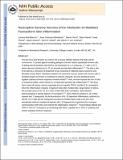| dc.contributor.author | Riol-Blanco, Lorena | en_US |
| dc.contributor.author | Ordovas-Montanes, Jose | en_US |
| dc.contributor.author | Perro, Mario | en_US |
| dc.contributor.author | Naval, Elena | en_US |
| dc.contributor.author | Thiriot, Aude | en_US |
| dc.contributor.author | Alvarez, David | en_US |
| dc.contributor.author | Wood, John N. | en_US |
| dc.contributor.author | von Andrian, Ulrich H. | en_US |
| dc.date.accessioned | 2015-01-05T18:26:00Z | |
| dc.date.issued | 2014 | en_US |
| dc.identifier.citation | Riol-Blanco, Lorena, Jose Ordovas-Montanes, Mario Perro, Elena Naval, Aude Thiriot, David Alvarez, John N. Wood, and Ulrich H. von Andrian. 2014. “Nociceptive Sensory Neurons Drive Interleukin-23 Mediated Psoriasiform Skin Inflammation.” Nature 510 (7503): 157-161. doi:10.1038/nature13199. http://dx.doi.org/10.1038/nature13199. | en |
| dc.identifier.issn | 0028-0836 | en |
| dc.identifier.uri | http://nrs.harvard.edu/urn-3:HUL.InstRepos:13581021 | |
| dc.description.abstract | The skin has a dual function as a barrier and a sensory interface between the body and the environment. To protect against invading pathogens, the skin harbors specialized immune cells, including dermal dendritic cells (DDCs) and interleukin (IL)-17 producing γδ T cells (γδT17), whose aberrant activation by IL-23 can provoke psoriasis-like inflammation1–4. The skin is also innervated by a meshwork of peripheral nerves consisting of relatively sparse autonomic and abundant sensory fibers. Interactions between the autonomic nervous system and immune cells in lymphoid organs are known to contribute to systemic immunity, but how peripheral nerves regulate cutaneous immune responses remains unclear5,6. Here, we have exposed the skin of mice to imiquimod (IMQ), which induces IL-23 dependent psoriasis-like inflammation7,8. We show that a subset of sensory neurons expressing the ion channels TRPV1 and NaV1.8 is essential to drive this inflammatory response. Imaging of intact skin revealed that a large fraction of DDCs, the principal source of IL-23, is in close contact with these nociceptors. Upon selective pharmacological or genetic ablation of nociceptors9–11, DDCs failed to produce IL-23 in IMQ exposed skin. Consequently, the local production of IL-23 dependent inflammatory cytokines by dermal γδT17 cells and the subsequent recruitment of inflammatory cells to the skin were dramatically reduced. Intradermal injection of IL-23 bypassed the requirement for nociceptor communication with DDCs and restored the inflammatory response12. These findings indicate that TRPV1+NaV1.8+ nociceptors, by interacting with DDCs, regulate the IL-23/IL-17 pathway and control cutaneous immune responses. | en |
| dc.language.iso | en_US | en |
| dc.relation.isversionof | doi:10.1038/nature13199 | en |
| dc.relation.hasversion | http://www.ncbi.nlm.nih.gov/pmc/articles/PMC4127885/pdf/ | en |
| dash.license | LAA | en_US |
| dc.title | Nociceptive Sensory Neurons Drive Interleukin-23 Mediated Psoriasiform Skin Inflammation | en |
| dc.type | Journal Article | en_US |
| dc.description.version | Version of Record | en |
| dc.relation.journal | Nature | en |
| dash.depositing.author | Ordovas-Montanes, Jose | en_US |
| dc.date.available | 2015-01-05T18:26:00Z | |
| dc.identifier.doi | 10.1038/nature13199 | * |
| dash.contributor.affiliated | Thiriot, Aude | |
| dash.contributor.affiliated | Ordovas-Montanes, Jose | |
| dash.contributor.affiliated | Alvarez, David | |
| dash.contributor.affiliated | von Andrian-Werburg, Ulrich | |


